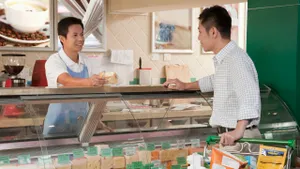Sustainability Award: Sobeys Progresses Toward Carbon, Waste-Diversion Goals
Additional Sustainability Awards coverage: Unified Grocers Finds Sustainability Inspiration From Within Kudrinko’s Thrives on Cutting Energy Costs
September 10, 2012
When it comes to their relationship with the environment, the key breakthrough for many retailers occurs when they decide to measure their environmental impact, applying the old adage “what gets measured gets done.”
For Sobeys, Stellarton, Nova Scotia, that decision was made in 2008. The company set two environmental goals to achieve by the close of its 2013 fiscal year (ending in early May) — to reduce its carbon footprint by 15% and increase the amount of waste diverted from landfills by 30% — and began to regularly measure its progress toward those goals.
Sobeys had always pursued energy efficiency and engaged in waste management, but in 2008 “we formalized our approach, and my role was created,” said David Smith, vice president, retail strategy and sustainability. In particular, Sobeys implemented a web-based database tool that reported — initially on a monthly basis but now quarterly — on the progress of its corporate stores in, for example, energy consumption (in kilowatt-hours per square foot).
 The energy consumption data is “harvested” from utility invoices and added to the database, allowing the company to compare energy efficiency across stores. “We can look at leaders and laggards,” Smith said. Moreover, the data gives Sobeys an indication of which stores would be the best fit for the installation of new technology aimed at boosting energy efficiency.
The energy consumption data is “harvested” from utility invoices and added to the database, allowing the company to compare energy efficiency across stores. “We can look at leaders and laggards,” Smith said. Moreover, the data gives Sobeys an indication of which stores would be the best fit for the installation of new technology aimed at boosting energy efficiency.
In its 2012 fiscal year — 80% of the way through its five-year plan — Sobeys’ corporate stores reduced their carbon footprint by 9.4%, distribution centers by 22% and corporate fleet by 12%, compared with the 2008 baseline number. The lion’s share of the carbon footprint — 84% — comes from the stores, so they are “going to have to pick it up” if Sobeys is to make its 15% overall reduction goal, Smith acknowledged. The DCs and fleet contribute 10% and 6%, respectively, to carbon emissions.
By contrast, the Kroger Co.’s total carbon footprint fell approximately 2% in 2011 (to slightly over 6.4 million metric tons of carbon dioxide equivalent) from the 2010 level, according to its annual sustainability report released last week.
In assessing its carbon footprint, Sobeys found that two-thirds is created by electricity consumption. To save on electricity, the company has retrofit lighting in glass-door freezers with Immersion RV40 LED lights from GE Lighting Solutions, which resulted in a 63% reduction in electricity usage; LED lighting is also standard in all new refrigerated merchandisers. The implementation of glass doors on medium-temperature dairy cases led to a 70% electricity savings.
After electricity, 28% of its carbon footprint derives from refrigerant leaks. “It was a surprise for many of us that [the percentage from refrigerant leaks] could be that high,” Smith said. As a result the company has begun deploying environmentally friendly transcritical refrigeration systems while cutting the leak rates of existing systems.
Finally, 5% of the company’s carbon footprint comes from the use of natural gas, propane and diesel fuel. During the past year Sobeys’ diesel-propelled fleet reduced its CO2-equivalent emissions intensity by 12% compared to 2008. Measures implemented include: reduction of idling time; use of appropriately sized and equipped vehicles that match the volume and weight of the loads to be delivered; equipping tractors and trailers with aerodynamic devices (cab roof fairings, trailer side skirts and trailer fairings); and maximizing the space available in the trailers.
For setting ambitious environmental goals and for making significant headway toward achieving them, Sobeys has been named the winner of SN’s 2012 Sustainability Excellence Award in the chain category.
The second largest Canadian food retailer after Loblaw Cos., Sobeys, owned by Empire Cos., is a sprawling, 1,333-store operation that encompasses four regional business units (Atlantic Canada, Quebec, Ontario and Western Canada). It operates 618 corporate stores, including supermarkets, convenience stores, drug stores and fuel centers — of which supermarkets contribute the vast majority of revenue — and supplies 715 franchised stores.
Read more: Curbing Carbon: SN Sustainability Excellence Awards
The company’s five-year sustainability plan applies to its corporate stores, but “a big part of the focus is demonstrating the value and influencing the franchisees,” said Smith. Many franchised stores are “very receptive” to sustainability improvements, such as those in Quebec that have adopted transcritical refrigeration systems.
So far, the business units have been individually driving Sobeys’ environmental efforts, with support from a small corporate team, but the company is still trying to strike the right balance between a centralized and decentralized approach, said Smith.
Cost avoidance — such as the money saved in being more efficient with electricity usage — is one of the key performance metrics in Sobeys progress reports. “Those are in the millions of dollars,” said Smith. “When we talk to people in the line of business, accountable for the P&Ls, that gets them to sit up and listen for sure.”
CO2 Pioneer
Sobeys has been a North American pioneer in the deployment of transcritical refrigeration systems that use only carbon dioxide as a refrigerant. (See “Refrigeration Systems Chillin’ With Carbon Dioxide,” SN, April 9, 2012.) When CO2 leaks from refrigeration systems into the atmosphere — in contrast to when it is produced by the combustion of fossil fuels — it contributes very little to global warming. That is why carbon dioxide is seen as a long-term alternative to conventional refrigerants, such as HFCs (hydrofluorocarbons), which have a global warming potential (GWP) up to 12,000 times that of CO2.
Sobeys now has 36 transcritical CO2 refrigeration systems in Quebec stores. Transcritical CO2 systems have been established as the company standard for new stores and significant store renovations. These systems have been found to cut energy costs for natural gas and electricity in Sobeys stores by 36% while virtually eliminating refrigerant leak-related greenhouse gas emissions.
Heat reclaim from the transcritical refrigeration systems is used to heat water and air spaces, including approximately 75% of hot water demands during peak times, and 100% during non-peak times. Seven of the transcritical systems capture the CO2 gas for water heating purposes without the need of a heat exchanger or pumping system. (Eight stores are being heated by natural gas recovered from landfill sites.)
Sobeys’ commitment to CO2-based refrigeration puts it ahead of the Paris-based Consumer Goods Forum’s 2010 pledge, which Sobeys has endorsed, to begin phasing-out HFC refrigerants as of 2015 and replace them with non-HFC refrigerants. (Smith is on the CGF’s global steering committee on sustainability.) The pledge by the CGF, made up of retailers and CPG firms, is a message to refrigeration manufacturers that “this is where we want to go” in the hope of spurring more deployment of non-HFC systems and “getting the cost-curve down,” Smith said.
Read more: Unified Grocers Finds Sustainability Inspiration From Within
Even as the price of transcritical systems comes down, the cost of retrofitting remains high, slowing down the retrofitting of existing Sobeys stores. As a result, Smith acknowledged, the transcritical system will represent a small percentage of the total installed base of refrigeration systems for “many years to come.” The company’s sustainability philosophy has to “align with our financial goals and business strategy,” he added. “Sustainability has a triple-bottom-line — environmental, social and financial.”
In the meantime, Sobeys is intent on reducing the leakage of its existing refrigerants. In the 2012 fiscal year, Sobeys cut its stores’ refrigerant emissions by 30.4% vs. the 2008 level. “We’ve had a tremendous improvement in leak reduction,” Smith said. “It’s a big example of what gets measured gets done.”
Waste Not
As for Sobeys’ five-year waste-diversion goal of 30% by 2013, stores were able to increase the amount diverted from landfill by 9.8% in fiscal 2012 compared with fiscal 2008. “It’s an aggressive goal, especially for stores, and we have a long way to go,” Smith noted. On the other hand, Sobeys’ warehouses increased their landfill-diverted waste by 30.4% in 2012, already achieving the corporate target. During fiscal 2012, Sobeys’ direct (total) operations diverted 48% of waste from landfill, increasing the volume of materials diverted by 2,200 metric tons (a 4% increase) compared with fiscal 2011. The materials included cardboard, organics, plastics, meat renderings, metals, and oils and fats.
One of the major challenges for stores is the lack of composting facilities in Canada to deal with organic waste. “It’s a systemic barrier we have not been able to overcome,” Smith said. To compensate, Sobeys has installed organic waste recycling units, which can reduce waste to landfills by 34%, at 44 stores in Ontario, and growing. The “organic paste” generated by the system can be used to make biogas.
 Seafood sustainability is an area Sobeys has focused on since introducing its Sustainable Seafood Policy in 2010. The company has de-listed all species of sharks, skates, rays, orange roughy and bluefin tuna; introduced 70 certified private-label seafood items; and devised a seafood-traceability program for consumers called ThisFish.ca, though the retailer was recently criticized by Greenpeace Canada for selling certain species such as farmed Atlantic salmon and Atlantic sea scallops.
Seafood sustainability is an area Sobeys has focused on since introducing its Sustainable Seafood Policy in 2010. The company has de-listed all species of sharks, skates, rays, orange roughy and bluefin tuna; introduced 70 certified private-label seafood items; and devised a seafood-traceability program for consumers called ThisFish.ca, though the retailer was recently criticized by Greenpeace Canada for selling certain species such as farmed Atlantic salmon and Atlantic sea scallops.
Sobeys’ approach is not just to purchase certified species, which are often the least endangered, but to address the most vulnerable fish like some species of tuna — “fix the worst first,” Smith said. To that end, Sobeys collects data on the stock status of targeted species. “If the stock status drops to a certain level, that should be a trigger to say, let’s ease up or stop catching the fish until it rebuilds,” he said. Another consideration is whether other types of marine life are being inadvertently caught, such as juvenile fish, marine mammals or sea birds.
To limit the environmental impact of its private-label packaging, Sobeys reduced the weight of a 500 milliliter water bottle by 25%, thereby cutting the annual volume of PET plastic required to produce it by 38.5 metric tons. The company also dropped the package weight of its private-label dressings by 85% by switching from glass to plastic containers.
Read more: Kudrinko’s Thrives on Cutting Energy Costs
Yet Sobeys is evolving in its thinking about packaging. “The packaging is typically under 10% of the environmental footprint of a product and packaging plays an important role in protecting it,” he explained. “So if you focus only on packaging and aim to light-weight it but the result is you cause more damage and waste more product, then you’ve shot yourself in the foot.”
 The upshot is that in addition to package reductions, Sobeys will consider using alternative material or improving the energy and water efficiency of the packaging production process. For example, it has started replacing seafood packaging cartons made of non-recyclable or difficult-to-recycle packaging materials (such as waxed cardboard and polystyrene) with cartons made of corrugate, a commonly recycled material.
The upshot is that in addition to package reductions, Sobeys will consider using alternative material or improving the energy and water efficiency of the packaging production process. For example, it has started replacing seafood packaging cartons made of non-recyclable or difficult-to-recycle packaging materials (such as waxed cardboard and polystyrene) with cartons made of corrugate, a commonly recycled material.
Sobeys has promoted the use of reusable grocery bags (pictured) in Ontario by charging 5 cents for each single-use plastic bag, extending a municipal law to that effect passed in Toronto. Compared with usage in 2005, Sobeys has reduced plastic bag usage by 52.4%, and with the 2006 introduction of plastic bag collection bins, the company has collected almost 300 million used plastic bags, which are recycled to make plastic products.
Sidebar: Spreading the Word
Sobeys is not only focused on sustainability in its own operations — it supports sustainability elsewhere as well.
In 2008, in partnership with Le Jour de la Terre Québec, Sobeys’ Quebec IGA retailers launched a fund to promote new sustainable development in communities across the province. To date, the fund has granted $4 million to nearly 400 community-based environmental initiatives.
Read more: Curbing Carbon: SN Sustainability Excellence Awards
In 2009, the company’s Ontario operations, in partnership with Earth Day Canada (EDC), created the Earth Day Canada Community Environment Fund. The fund provides grants of up to $20,000 to community-based environmental initiatives, and is open to all Canadian community-based, not-for-profit organizations and schools supporting environmental projects in Ontario. Since its inception, the fund has awarded more than $1.1 million to 80 community-based environmental initiatives.
About the Author
You May Also Like








